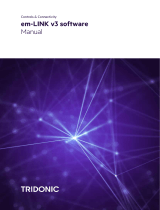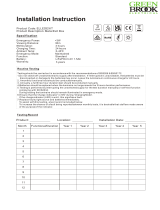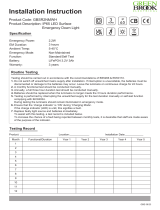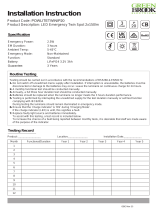
www.tridonic.com 6
Subject to change without notice.
Data sheet 05/16-EM034-11
Emergency lighting units
EM converterLED
LED Driver compatibility
The EM converterLED emergency unit use 3 pole technology and is compatible
with most LED Drivers on the market, however it is important to check that the
rating of the LED Driver does not exceed the values specified below:
• The max. allowed output current rating of the associated LED Driver is 2.4 A
peak (current rating of switching relays of EM converterLED)
• The max. allowed inrush current rating of the associated LED Driver is 60 A
peak for 1 ms (inrush current rating of switching relay of EM converterLED)
• The max. allowed output voltage of the associated LED Driver applied to the
EM converterLED output is 450V (voltage withstand between adjacent contact
of the single switching relay of the EM converterLED)
• The max. allowed LED load of the associated LED Driver is 150 W in
operation. The load must be an LED module.
Life-time
Average life-time 50,000 hours under rated conditions with a failure rate of less
than 10 %. Average failure rate of 0.2 % per 1000 operating hours.
Maximum lead length
LED 3 m1
Status indication LED 1 m
Batteries 1.3 m
Isolation and electric strength testing of luminaires
Electronic LED Drivers can be damaged by high voltage. This has to be considered
during the routine testing of the luminaires in production.
According to IEC 60598-1 Annex Q (informative only!) or ENEC 303-Annex A, each
luminaire should be submitted to an isolation test with 500 VDC for 1 second. This
test voltage should be connected between the interconnected phase and neutral
terminals and the earth terminal. The isolation resistance must be at least 2 MΩ.
As an alternative, IEC 60598-1 Annex Q describes a test of the electrical strength
with 1,500 VAC (or 1,414 x 1,500 VDC). To avoid damage to the electronic devices
this test must not be conducted.
Technical data batteries
Accu-NiCd
Case temperature range
to ensure 4 years design life
4.2 / 4.5 Ah D +5 °C to +55 °C
1.6 Cs +5 °C to +50 °C
Battery voltage/cell 1.2 V
Single cell dimensions
4.2/ 4.5 Ah D
Diameter 32.5 mm
Height 60.5 mm
1.6 Ah Cs
Diameter 22.5 mm
Height 42.5 mm
Capacity D 4.2 / 4.5 Ah
Capacity Cs 1.6 Ah
Max. short term temperature (reduced life-time) 70 °C
Max. number discharge cycles 4 cycles per year plus
4 cycles during
comissioning
Packing quantity 5 pcs. per carton
Accu-NiMh
Case temperature range
to ensure 4 years design life
2.0 Ah Cs +5 °C to +55 °C
4.0 Ah LA +5 °C to +40 °C
Battery voltage 1.2 V
Single cell dimensions
2.0 Ah Cs
Diameter 22 mm
Height 42.5 mm
4.0 Ah LA
Diameter 18.3 mm
Height 90 mm
Capacity Cs / LA 2.0 Ah / 4.0 Ah
Max. short term temperature (reduced life-time) 70 °C
Max. number discharge cycles 2.0 Ah Cs 4 cycles per year plus
4 cycles during
comissioning
Max. number discharge cycles 4.0 Ah LA 2 cycles per year plus
4 cycles during
comissioning
Packing quantity 5 pcs. per carton
Mechanical details
Casing manufactured from polycarbonate.
Glow-wire test according to EN 61347-1 with increased temperature of 960 °C
passed.
LED status indicator
• Green
• Mounting hole 6.5 mm dia
• Lead length 0.3 m / 1.0 m
• Insulation rating: 90 °C
• Plug connection
Test switch
• Mounting hole 7.0 mm dia
• Lead length 0.55 m
• Plug connection
Battery leads
• Quantity: 1 red and 1 black
• Length: 1.3 m
• Wire type: 0.5 mm2 solid conductor
• Insulation rating: 90 °C
Battery end termination
Push on 4.8 mm receptacle to suit battery
spade fitted with insulating cover
Module end termination
8.0 mm stripped insulation
Two-piece batteries are supplied with a 200 mm lead with 4.8 mm receptacle at
each end and insulting covers to connect the separate sticks together.
1 Note: The length of LED leads to the LED module must not be exceeded. Note that the length of the
EM converterLED leads is added to the length of the leads from the LED Driver to the EM converterLED
module when considering max. permitted lead length of the LED Driver. Leads should always be kept
as short as possible.
Storage, installation and commissioning
Relevant information about storage conditions, installation and commissioning are
provided in the battery datasheets.

















